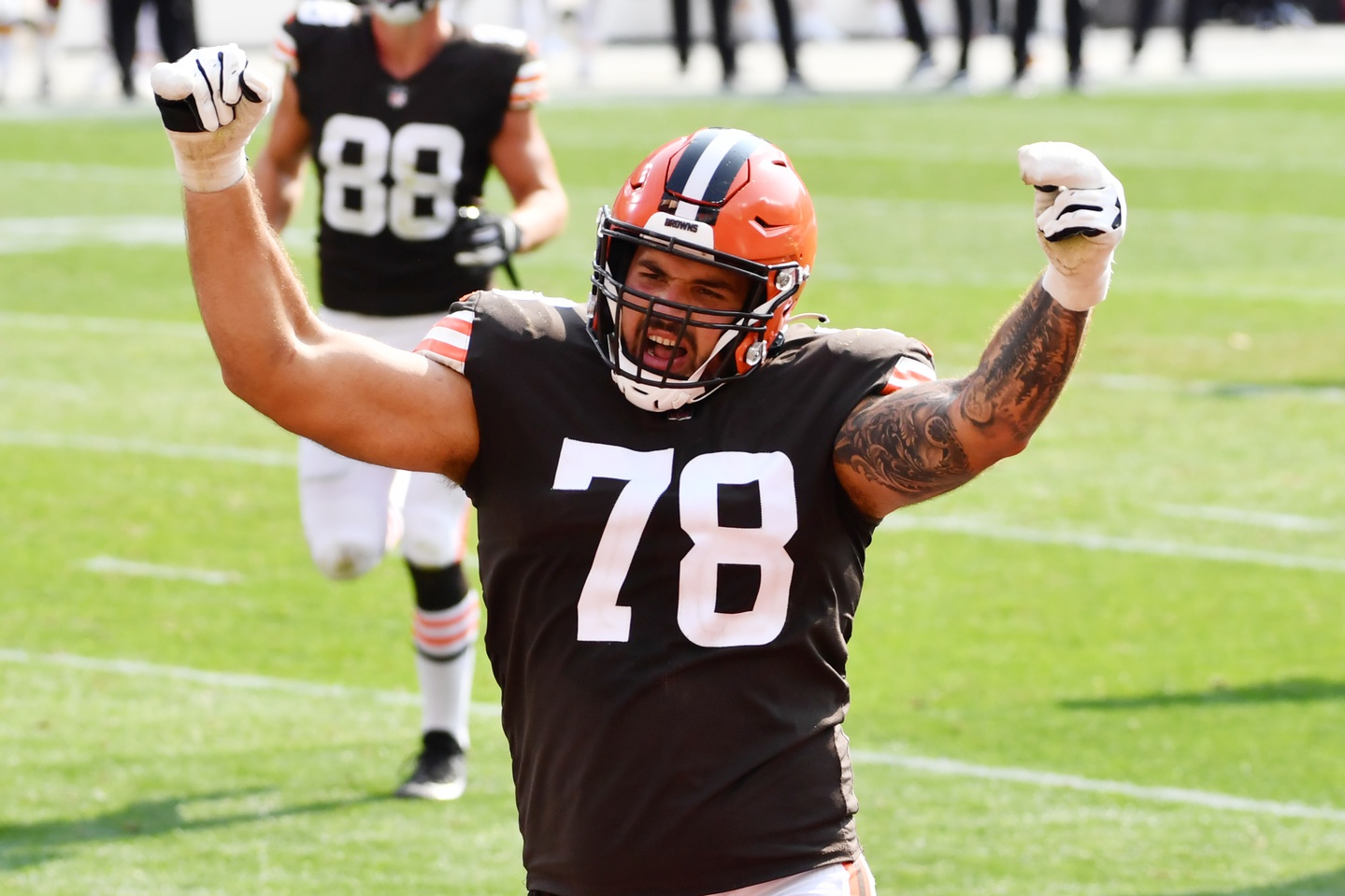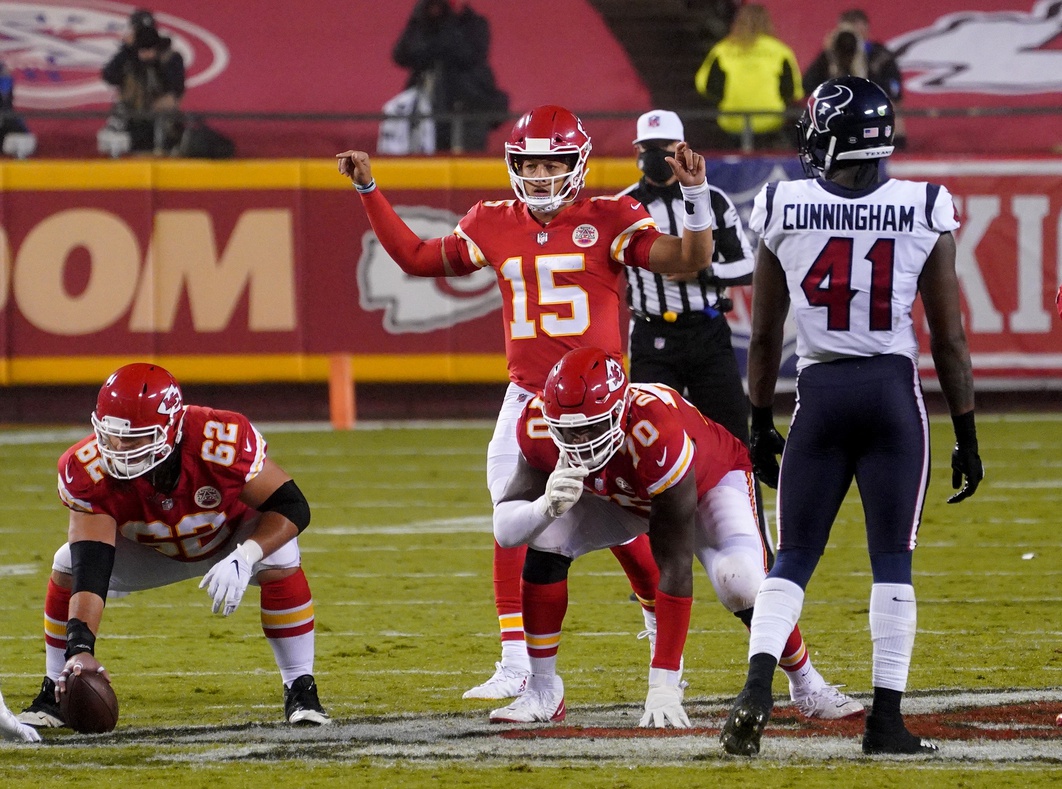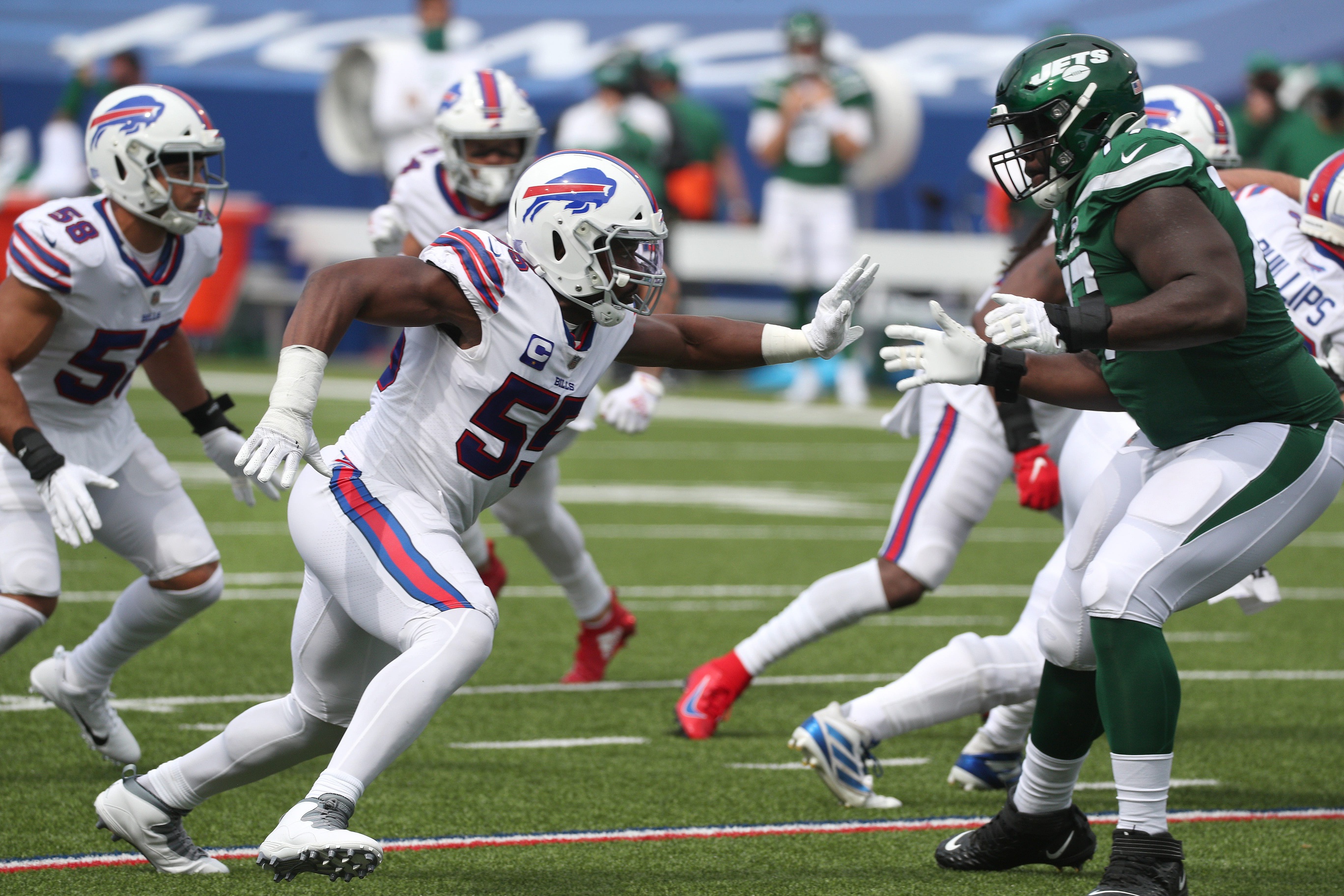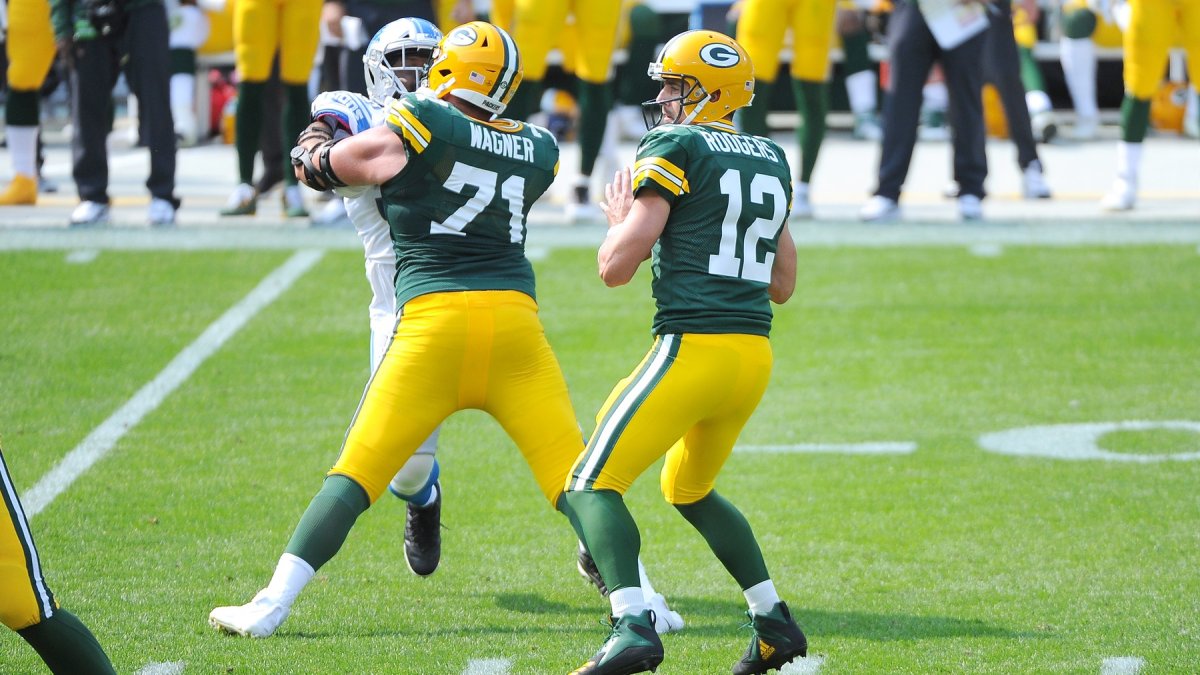One of the biggest storylines each NFL season revolves around the big men on the line of scrimmage. A top-tier offensive line can enable a team's offense to reach near-unstoppable heights, whereas the opposite can doom an offense to mediocrity.
Three weeks is certainly early to throw everything out of the window and take a look at the current state of the league, but let’s do it anyway and see what the results have shown us so far.
[Editor's Note: PFF's advanced statistics and player grades are powered by AWS machine learning capabilities.]
1. Green Bay Packers
Pressures allowed: 10
Rush yards before contact average: 2.2
Everything in Green Bay has been righted thanks to an offseason of adding almost nothing positive to the equation. Aaron Rodgers looks like MVP Aaron Rodgers for the first time in more than half a decade, and the offensive line is back to its best — due in no small part to Rodgers' play.
While the Packers' offensive line has been the best pass-blocking unit in the game in the past, it has typically blocked for a signal-caller who holds onto the ball longer than most quarterbacks. All of a sudden, Rodgers has an average time to throw of just 2.49 seconds, and the line looks impenetrable.
2. New England Patriots
Pressures allowed: 14
Rush yards before contact average: 2.1
Much of the New England offensive line's decline last season was due to a lack of receiver separation and the increased length of time Tom Brady had to hold onto the football. By pivoting to a run-heavy scheme with Cam Newton under center, the team has been able to mitigate much of that issue.
Plus play from young offensive linemen, such as rookie Michael Onwenu and third-year tackle Jermaine Eluemunor, has also gone a long way in boosting the grades of the Patriots' line. New England now has a unique and diverse offense that causes defenders all kinds of problems, creating just enough hesitation to steal an advantage for their offensive line up front.
3. Cleveland Browns
Pressures allowed: 15
Rush yards before contact average: 1.2
One of Cleveland’s big offseason tasks was to revamp its offensive line and ensure that it could no longer be a reason for Baker Mayfield’s regression in play. The Browns attacked the problem in both free agency (Jack Conklin) and the draft (Jedrick Wills Jr.), and so far, both players have provided clear upgrades at the two weakest points on the line from a year ago.

Conklin’s success was always probable, but Wills also hitting the ground running is a complete win for the Browns. It’s likely no coincidence that Mayfield has looked much more comfortable in the pocket — outside of the Week 1 game against the Ravens — than he did in 2019.
4. Baltimore Ravens
Pressures allowed: 17
Rush yards before contact average: 2.9
The Ravens' offensive line is still one of the best in the game, boosted by their unique offense and run-heavy disposition, but Marshal Yanda‘s retirement has certainly left a mark. Baltimore’s lowest-graded player on offense at any position through three weeks has been the man playing in Yanda’s spot — third-round rookie Tyre Phillips.
And while he has posted a better PFF grade each week, he has still yet to clear an average mark. The Ravens will be hoping they get improved play at that position as the year wears on, but a weak link along the line is the only thing preventing this unit from rivaling the Packers' group as the best in the league.
5. Tampa Bay Buccaneers
Pressures allowed: 19
Rush yards before contact average: 1.3
Tampa Bay was another team that had a solid line on paper heading into the 2020 season but was relying on immediate plus play from a rookie at one of their spots. And so far, they have been rewarded with Tristan Wirfs‘ play at right tackle. He debuted against Cameron Jordan and was able to keep his head above water, which was immediately encouraging.
And through three games, Wirfs has yet to allow a sack on Tom Brady, surrendering only five total pressures. The interior of this line is arguably the best in football right now, and while Donovan Smith is frustrating at times, his baseline is, perhaps, not as bad as his lowlight reel.
6. Indianapolis Colts
Pressures allowed: 18
Rush yards before contact average: 1.3
The preseason narrative on this offensive line has certainly been true to form through three weeks. This is the best unit that has ever been put in front of Philip Rivers, and that was probably a necessity due to his age. The Colts are a classic example of a line with no weak links right now.
Obviously, their best player is Quenton Nelson, but a line is only as good as the weakest member. And Indianapolis has no one who in the starting five who is a consistent problem, which allows Rivers an extremely solid platform from which to work. They are also a stronger run-blocking group than they are in pass protection, which can only bode well for Jonathan Taylor now that he has to carry the load.
7. New Orleans Saints
Pressures allowed: 16
Rush yards before contact average: 1.4
Injuries have been nipping at the Saints' offensive line, but this group had a built-in contingency plan in the form of first-rounder Cesar Ruiz. The tackles form the best pairing in football, and center Erik McCoy is quickly becoming one of the best centers in the league.
The only thing keeping the Saints this low in the rankings is how much they are being protected as a group by Drew Brees barely attempting any passes beyond 10 yards and averaging one of the quickest times to throw. This group has a significantly easier job in pass protection than most other lines.
8. Los Angeles Rams
Pressures allowed: 17
Rush yards before contact average: 2.1
One of the stories of the young season so far has been the massive improvement of this group, which has almost determined the Rams' fortunes over the past several years. When the line collapsed a season ago, so did any chance of the team going back to the Super Bowl.
But for them to jump back into the top 10 through three games makes the team a completely different animal. Andrew Whitworth remains ageless, still hammering out elite PFF grades despite closing in on his 39th birthday, while Rob Havenstein has had a much-needed bounceback to better play.
9. Pittsburgh Steelers
Pressures allowed: 22
Rush yards before contact average: 1.8
Stability had been the strength of Pittsburgh’s offensive line for years, and that has been tested a little lately, causing a notable difference in the overall play of the unit. While the left side of the line has played every snap so far, the right side has been more disorderly, with backups pressed into action at both guard and tackle at various points.
The lowest-graded players on the line have been those backups, so there is pretty good reason to expect this unit to jump in the rankings as the season wears on if it can get more consistent play out of that side and get healthy starters back — particularly David DeCastro, who debuted this past week against Houston.
10. Kansas City Chiefs
Pressures allowed: 23
Rush yards before contact average: 1.5
The strength of the Chiefs' offensive line is its tackles, with Mitchell Schwartz arguably the best right tackle in football and Eric Fisher a solid player enjoying an unusually strong start (90.4 pass-blocking grade) to his season.

Austin Reiter is a solid player at center, but the question marks are at guard, particularly with Laurent Duvernay-Tardif opting out of the season to continue working in the medical field during the pandemic. Replacing his production has been a struggle, and while Kelechi Osemele on the other side has had some highlight-reel blocks, his down-to-down efficiency remains patchy overall.
11. Chicago Bears
Pressures allowed: 27
Rush yards before contact average: 1.6
The Chicago offensive line is a great example of how much a quarterback can control the production of his front-five. With last year’s Mitchell Trubisky at the helm, Chicago’s blockers had one of the toughest assignments in the game.
With the 2020 version, they had been enjoying a much more comfortable time of it, until the Atlanta game. Now with a switch at quarterback, we get to see how Nick Foles will affect their roles. But this group has been performing well through three games, with Germain Ifedi playing significantly better at guard than he had at tackle for the Seahawks (or, to be fair, when he previously played guard for them, too).
12. Detroit Lions
Pressures allowed: 28
Rush yards before contact average: 1.4
The best player on Detroit’s offensive line so far has been Taylor Decker, who has backed up the contract extension he recently signed with play that would put him on course for a career year. Decker has yet to surrender a sack and has allowed just five hurries through three games, including performances against legitimate pass-rushers.
Frank Ragnow has continued his emergence as one of the best young centers in the league, and rookie Jonah Jackson has been a pleasant surprise at one of the guard spots. If the Lions could get improved play at the other one, this line could quickly jump into the top 10.
13. Jacksonville Jaguars
Pressures allowed: 28
Rush yards before contact average: 1.5
Jacksonville’s offensive line has been remarkably solid through three weeks, with no real weak links and no starter earning a PFF grade below 63.6 overall. The interior of the line has been the strongest area, but what keeps the unit away from the top 10 is a lack of any standout performers.
Though the lowest-grade of the group is an average mark in the 60.0s, their high watermark is below 80.0, with Andrew Norwell leading the way with a 77.2 grade. Overall, all five starters grading above average is preferable to a mix of superstars and disasters, but it provides this unit room for growth moving forward.
14. Philadelphia Eagles
Pressures allowed: 33
Rush yards before contact average: 1.2
It’s easy to think of everything Eagles right now as a disaster, given their 0-2-1 start, and the way injuries attacked the offensive line only reinforces that mindset. But this line was coming down from a period of being the best in the league, so even while banged up and reeling, this is still a middle-of-the-road offensive line.
Jason Peters hasn’t been the force he once was at left tackle, which was predictable due to his age and the fact that he was supposed to play guard this year before a reshuffle, and Isaac Seumalo had been a weak link at left guard through two weeks before injury forced him out of the lineup. Overall, the pieces of a good group still exist in Philadelphia, and it isn’t a bad line despite the reshuffling.
15. Seattle Seahawks
Pressures allowed: 33
Rush yards before contact average: 1.6
The Seattle Seahawks' offensive line has slowly improved over time, and with Russell Wilson firing on all cylinders this season so far, the unit looks better than it has in a long time.
Duane Brown remains its best member at left tackle, allowing just one sack through three games, but the biggest pleasant surprise could be the play of rookie right guard Damien Lewis. Pass blocking has been the weaker area of his game so far, but he has been a force as a run blocker and has allowed just one sack through three weeks.
16. San Francisco 49ers
Pressures allowed: 26
Rush yards before contact average: 2.4
The 49ers' offensive line is well protected by the offensive system, and it’s no coincidence that Kyle Shanahan tends to draw career years out of not just skill position players but offensive linemen, as well. Trent Williams has been a huge addition, allowing the continuity of plus play at the left tackle position.

His 80.4 overall PFF grade is the group’s best, and it sits in the same kind of ballpark as the player he replaced, Joe Staley, from a season ago (81.3). Williams has allowed just two total pressures in three weeks and already has a block of the season candidate on his highlight reel against Arizona. The biggest area for concern for this group is depth — there's been a significant dropoff when starters have headed to the sideline.
17. Buffalo Bills
Pressures allowed: 33
Rush yards before contact average: 0.9
Buffalo’s construction of a top-tier roster over the past few seasons has been remarkable to watch, and the offensive line is a big part of that. They used to have one of the poorer groups in the league, and while it isn’t among the best anymore, it is certainly good enough for the rest of the offense to thrive.
Cody Ford has struggled the most inside at guard, but he has also had to run up against Aaron Donald already this season, which helps explain some of the 11 total pressures he has surrendered. Daryl Williams is quietly back playing at a level that is approaching his best, which was starting to seem like a mirage of a season in Carolina in 2017.
18. Tennessee Titans
Pressures allowed: 22
Rush yards before contact average: 1.3
The Titans ended 2019 with a top-10 offensive line, according to our rankings, but they then let Jack Conklin walk in free agency, which was always going to have a detrimental effect. Ironically, his replacement in Dennis Kelly has been one of their better performers, and the line as a whole has just not been able to recapture its form from last season yet.
Right guard Nate Davis has taken a step forward, but he remains the weakest link (59.8 PFF grade). However, his pass blocking has been a huge improvement, and he has yet to surrender a sack after being beaten for eight in his rookie year.
19. Atlanta Falcons
Pressures allowed: 27
Rush yards before contact average: 2.1
The play of the young players on the right side of the line, Chris Lindstrom and Kaleb McGary, was supposed to determine how good this unit would be going forward, but an injury to McGary has paused that development for now. Matt Gono, McGary’s replacement, has been a weak link on the chain, earning just a 42.5 PFF pass-blocking grade, which plummeted to 19.6 in his first game starting. This line has the makings of a group that is significantly better than its current play, but it needs healthy starters for it to happen.
20. Las Vegas Raiders
Pressures allowed: 27
Rush yards before contact average: 1.3
It’s a common theme for a team that has suffered injuries to find itself quickly sliding down the offensive line rankings — such is the state of backup line play at the NFL level. The Raiders have one of the best interior lines in football, but the dropoff from Richie Incognito to rookie backup John Simpson has been about as precipitous as possible.
Simpson has just a 35.7 overall PFF grade since replacing Incognito and has allowed nine total pressures on less than two games' worth of snaps. Trent Brown has also left a problem spot at right tackle, though Denzelle Good has been less of a problem as his replacement.
21. Houston Texans
Pressures allowed: 34
Rush yards before contact average: 1.1
When you consider the Texans' opponents over the first three weeks of the season, their performance looks significantly better. Despite that gauntlet, Laremy Tunsil has graded legitimately well, and his mark of 83.6 overall is the fourth-best grade of any tackle in 2020.
Nick Martin has been solid at center, but the Texans are undone by the weak links in the chain, with Max Scharping (49.1), Tytus Howard (54.8), Senio Kelemete (58.2) and Zach Fulton (58.2) all seeing significant snaps and grading below average.
22. Dallas Cowboys
Pressures allowed: 34
Rush yards before contact average: 1.3
Oh, how the mighty have fallen. Dallas, once purveyors of All-Pro offensive line play across the board, has been dealing with injuries to compound the loss of talent along the line. And through three weeks, the line has been a problem area, not a strength.

Zack Martin has been the lone bright spot, even kicking out to play right tackle and doing well against Seattle this past week (just one hurry allowed), but undrafted rookie Terence Steele has held up about as well as you would expect from an undrafted rookie — not at all well. Steele has surrendered 10 total pressures and been flagged three times in three games, and the numbers would have been worse but for Dak Prescott’s ability to mitigate the problems.
23. Denver Broncos
Pressures allowed: 37
Rush yards before contact average: 0.7
You know the offensive line is struggling when everybody’s favorite complaint — Garett Bolles at left tackle — has actually been the strongest member of the group. Bolles is on his way to a career year and has yet to have a bad game in 2020. He has surrendered just three total pressures in three games, even if his penalty count remains high (two in three games).
Dalton Risner alongside him continues to encourage, but the play of the other three members of the line has been a concern, with the trio combining to surrender 27 total pressures through three games — almost three times more than the entire Packers line has.
24. Carolina Panthers
Pressures allowed: 27
Rush yards before contact average: 0.8
The Panthers' tackle play has been strong, with both Taylor Moton and Russell Okung earning PFF grades above 70.0 overall, but the trade for Okung sent an interior lineman in the other direction, and Carolina's interior has been a major problem.
Each of their two guards has a grade in the 50.0s, and Matt Paradis‘ grade has somehow gotten even worse from what was by far the worst grade of his career last season. Paradis has at least been better in pass protection, but he continues to struggle outside of the confines of Denver’s blocking scheme.
25. Washington Football Team
Pressures allowed: 35
Rush yards before contact average: 1.0
While all the attention has been on the play of Dwayne Haskins at quarterback, the situation in Washington has not been good to him, and that extends to the offensive line. Their group has had some solid play, but line cohesion is far more about the weakest link than it is the strongest player, or even the average of the five.
Wes Martin at guard has an overall PFF grade of just 51.2, and Geron Christian's play at left tackle has been a problem in two of the three games so far, albeit against some pretty fierce opposition. He has also been flagged for four penalties in three weeks.
26. Arizona Cardinals
Pressures allowed: 28
Rush yards before contact average: 1.8
The Arizona Cardinals are a great example of how far a team can offset questionable offensive line play with scheme and quarterback. Kliff Kingsbury’s spread offense, combined with super-wide offensive line splits between linemen, gives this team unique quirks that cause defenses problems and negate some of the individual struggles they have as a group.
Their tackle play has actually been OK, but the interior trio has struggled badly through three games, which is especially problematic when you consider they are blocking for the shortest quarterback in the league.
27. Minnesota Vikings
Pressures allowed: 30
Rush yards before contact average: 2.3
Much has been made of the Vikings' struggles on defense, but the offensive line's regression has flown under the radar a little after the unit had been creeping back toward viability. Brian O’Neill is the best player they have up front, but even he has allowed seven total pressures through three games and earned a pass-blocking grade of 66.4. Their guard play has been atrocious, with both new starters earning grades of lower than 50 overall, and Dru Samia appearing on one of the lowlights of the season as he was tossed to the ground by Deforest Buckner against Indianapolis.
28. New York Jets
Pressures allowed: 42
Rush yards before contact average: 0.7
The Jets threw a lot of resources at the offensive line this offseason, and it has had predictably mixed results so far. First-round draft pick Mekhi Becton has been the brightest spot, earning three straight good grades and allowing just four total hurries, but he also left the game against the Colts with an injury.

New acquisitions, such as Connor McGovern, have been dramatically less successful, and the Jets' offense as a whole is not helping the group out with a lack of healthy receivers and a struggling quarterback.
29. Cincinnati Bengals
Pressures allowed: 53
Rush yards before contact average: 1.1
The good news for Cincinnati is that Jonah Williams — in what is effectively his redshirt rookie year — looks like the first-round talent he was billed as. He has been extremely solid through three weeks against some pretty legitimate opposition.
The bad news is that everybody else on the line is a problem, and the Bengals have been forced to dip into their bench, which is even worse. Former first-round draft pick Billy Price had an 11.5 PFF pass-blocking grade against the Eagles, which is concerning on a 0-100 scale.
30. Los Angeles Chargers
Pressures allowed: 32
Rush yards before contact average: 1.0
It doesn’t seem to matter what changes the Chargers make — by Week 3 every season, they seem to be in the seventh circle of hell when it comes to their offensive line, and here we are once more. Bryan Bulaga has been a huge upgrade and a great addition, but he was injured this past week. His replacement, Trey Pipkins, was victimized by a defensive line that had generated just nine total pressures heading into that game.
Similarly, Panthers top draft pick Derrick Brown had back-to-back PFF grades in the 30.0s before playing the Chargers and posting an 84.6 mark. Given the state of the Chargers' line, Justin Herbert‘s play has been all the more remarkable.
31. New York Giants
Pressures allowed: 46
Rush yards before contact average: 0.7
It’s fair to point out that the Giants have faced some tough competition, but it doesn’t excuse their overall level of play through three weeks. Starting center Nick Gates had literally never played a snap of center before in his career, and he currently has a 49.7 overall PFF grade.
Andrew Thomas is the one first-round rookie tackle who has struggled right out of the gate, though he had back-to-back games against elite competition. Even Kevin Zeitler, typically one of the best pass-blocking guards in the game, has struggled this season, allowing eight total pressures through three games.
32. Miami Dolphins
Pressures allowed: 25
Rush yards before contact average: 0.9
The Miami Dolphins have had the worst offensive line in the league for some time now, and though they have thrown some resources at it, they have yet to dramatically alter the final product. That goes some way toward explaining why we have yet to see Tua Tagovailoa at quarterback — and why we may not for some time.
First-round rookie tackle Austin Jackson’s numbers look OK — he has allowed just six total pressures in three games — but Ryan Fitzpatrick has been excellent at getting rid of the ball before pass protection losses become pressures, and Jackson’s 52.7 pass-blocking grade better reflects those losses.



 © 2025 PFF - all rights reserved.
© 2025 PFF - all rights reserved.